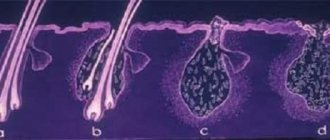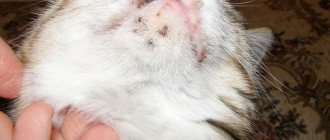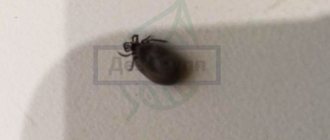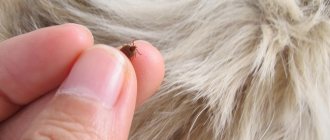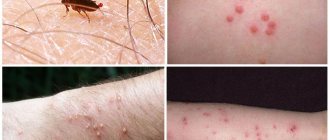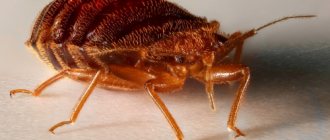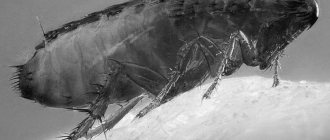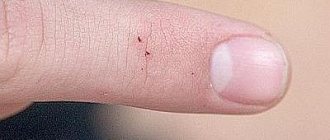What is demodicosis in dogs?
Biologists have discovered more than a hundred species of Demodex; only three parasitize dogs:
- Demodex canis;
- Demodex cornei;
- Demodex injai.
Hundreds of studies have been published on these parasites, but questions still remain. In many publications, the demodex mite is described as a permanent inhabitant of the skin of all dogs, which multiplies when the immune system fails. This information is contradicted by a study of scrapings from healthy dogs without external signs of demodicosis. Of the 415 animals, only 36 were found to have ticks. The results of the study are described in a textbook on veterinary medicine.
A subcutaneous mite cannot be seen without a microscope; its body length does not exceed 0.26 mm. Once on the skin, the parasite penetrates into the cavity of the hair follicle, sebaceous glands and excretory ducts. As it moves, it gnaws out paths in the epithelium, destroying the cells of the follicle, epidermis, and hair roots.
The life cycle of demodex lasts 25–30 days. During this time, the female lays dozens of eggs in the hair follicles. As the colony of parasites multiplies, it grows and conquers new living space. And the animal develops a demodectic focus.
Any dog can get demodicosis, regardless of gender, age and breed. But according to observations, the subcutaneous mite more often attacks short-haired animals:
- French, English, American bulldogs;
- Rottweilers;
- boxers;
- Dobermans;
- bull terriers;
- dachshund;
- German Shepherds and Great Danes;
- Staffordshire Terriers;
- Shar Pei.
Short hair does not protect well from external irritants, so dogs actively secrete sebum - a breeding ground for parasites.
Diagnostic methods
To make a diagnosis, the veterinarian must take a medical history and examine the patient. Thanks to the owner's answers, he can find out the cause of the disease even before conducting research.
The symptoms caused by Demodex are similar to other mites, allergies, trichophytosis, microsporia, nutritional dystrophy and some infections. The type of pathogen is determined by scraping.
Scraping
Scraping is the main test for demodicosis in dogs, which is taken from the affected skin. To do this, it is pre-squeezed, provoking the release of parasites from the tunnels closer to the hair roots. Biomaterial is taken from several lesions at once to increase the accuracy of the analysis.
Other tests
In addition to scraping, other studies are also carried out. These include:
- general and biochemical blood and urine tests, revealing intoxication by waste products of parasites;
- bacteriological culture, used in the presence of a secondary infection to determine the type of bacterium and its sensitivity to antibiotics;
- trichoscopy, which determines the condition of the hair follicles;
- Ultrasound and x-rays recording the condition of internal organs.
After determining the cause and form of the disease, the veterinarian draws up an individual treatment plan. The owner must strictly follow all his recommendations. Acaricides are very toxic, so an overdose can lead to very unpleasant consequences.
Is canine demodicosis contagious to humans and other dogs?
People also suffer from demodicosis, but other species live on them: Demodex brevis and Demodex folliculorum. A dog tick can land on human skin, but will not be able to feed or reproduce and quickly dies in an alien environment.
With close, prolonged contact, adult ticks move from one dog to another. However, the likelihood of developing the disease depends on the state of the immune system. The risk group includes:
- weakened dogs;
- sick and recovering;
- elderly over 10 years old;
- puppies up to one year;
- animals with skin lesions.
A healthy dog with a normal immune system will not get demodicosis even after close contact with a sick animal.
Dog ticks are not dangerous for cats. They are parasitized by other species of Demodex - Demodex gatoi, Demodex cati.
Possible consequences and complications
The rate at which your pet heals depends not only on the degree of damage, but also on the owner’s reaction. If you contact the clinic in a timely manner, more than 96% of the animal will recover. With a prolonged generalized form, not only secondary fungal and bacterial diseases of the skin can develop, but also heart, liver and gastric failure.
Demodicosis is often accompanied by eye diseases (conjunctivitis), dermatitis and allergies.
The health of a dog depends on several factors: heredity, environmental conditions, and the responsibility of the owner. The largest percentage is allocated to the owner. If a dog breeder recognizes the problem in time and tries to solve it, then the pet has a great chance of a speedy recovery.
4.7 / 5 ( 4 voices)
Forms of demodicosis in dogs
Based on the area of damage, there are 2 forms:
- Localized – up to 4 demodectic lesions up to 2.5 cm in size.
- Generalized – 5 or more scattered affected areas or extensive skin damage. This form occurs as a continuation of an untreated focal form or develops independently.
The division is conditional, since the ratio of the size of the dog and the affected areas is taken into account. For example, 3 lesions with a diameter of 2 cm for a Chihuahua are already generalized demodicosis, and 5 affected areas of 3 cm for a mastiff are a localized form of the disease.
Separately, pododemodecosis and otodemodecosis are distinguished. In the first case, lesions form on the paws and fingers. In the second, the parasite infects the surface of the ear.
Why are subcutaneous ticks dangerous for dogs?
With demodicosis, the disease occurs in a scaly or pustular form. In the first case, the skin turns red and cracks , and in the second, it becomes moist and wrinkled due to the formation of ulcers and ulcers.
In the absence of treatment, the localized form develops into a generalized form, combining the symptoms of scaly and pustular demodicosis. This form often occurs with complications and is difficult to treat.
If the disease spreads throughout the body, then the animal has problems with:
- stomach;
- lymph nodes;
- spleen;
- kidneys;
- liver.
Due to the resulting wounds, the dog’s body becomes vulnerable to pathogenic microorganisms. A secondary infection enters the ulcers, which poses a serious danger if the immune system is weak. The animal may die from sepsis.
In this regard, it is necessary to carry out a diagnosis at the first alarming signs that change the pet’s usual behavior.
Juvenile demodicosis in dogs under 1.5 years of age
Demodex mites are transmitted to puppies from their mother within 2–3 days after birth. Most kitties become asymptomatic carriers; the parasites do not affect health in any way. If the fragile immune system cannot cope and does not restrain the proliferation of parasites, by 3 months or later the puppy will develop demodicosis.
An additional burden in the 1st year of life is vaccinations, changing teeth, and cupping. These events can trigger stress, a dangerous enemy of the immune system. Focal juvenile demodicosis in 90% of cases goes away as the puppy grows up and develops immunity.
For the development of the generalized juvenile form, genetic prerequisites are needed. The reproduction of mites is inhibited by the T-link of the immune system, which recognizes and removes foreign agents. Dogs with defects in protective T cells are themselves prone to generalized demodicosis and pass this defect on to their offspring.
Sources of infection
Demodex and scabies mites are ubiquitous. The main sources of infection in pets are:
- Animals suffering from demodicosis, sarcoptic mange and notoedrosis. Arachnoses are characterized by seasonal outbreaks in late autumn - early spring, when the frequency of contact between dogs and wild carnivores and rodents increases. If demodicosis and sarcoptic mange are most often carried only by sick dogs, then cats and rodents can also be carriers of sarcoptic mange.
- Care items. The causative agents of arachnosis can remain viable in the external environment for several days, so a healthy dog can become infected through contact with contaminated bedding, brush, or toy. Brand new care items just purchased from a specialty store can be contagious.
IMPORTANT!!! A loving owner can bring parasites into the premises from the street, so before contacting a pet, you must remove outer clothing and shoes, and wash your hands thoroughly with soap!
An exacerbation of arachnoses is observed in emaciated, weakened and young animals, after suffering from diseases, against the background of stress, metabolic disorders, neoplasms, poor quality maintenance and feeding.
Even one scabies mite causes the development of the disease; demodicosis manifests itself only when the following provoking factors act on the dog’s body:
- Vaccination;
- Weaning;
- Stress;
- Pregnancy;
- Puberty;
- Genetic predisposition;
- Oncology;
- Diabetes;
- Hormonal disorders;
- Heredity.
Conscientious breeders do not allow individuals suffering from demodicosis to be bred in order to avoid the spread of arachnosis.
Causes of demodicosis in adult dogs
In animals older than 18 months, demodex mites more often “wake up” against the background of other disorders that reduce the overall immunity and barrier functions of the skin:
- bacterial, allergic dermatitis;
- hormonal imbalance;
- infection with worms;
- oncological diseases;
- autoimmune pathologies.
Dogs with impaired hair growth and decreased skin tone are predisposed to the development of demodicosis. It is easier for a subcutaneous mite to penetrate into the cavity of the follicle when the hair grows slowly after molting or the root does not adhere tightly to the walls of the hair follicle.
Often demodicosis begins when the hormonal balance changes. This happens during pregnancy, after estrus or long-term treatment with corticosteroids. Hormonal drugs save from severe inflammation, but lead to the death of lymphocytes and suppress the immune system.
During the treatment of demodicosis, corticosteroids are completely excluded.
Unbalanced nutrition, lack or excess of macro and micronutrients affects the condition of the skin and disrupts protective functions. The dog's hair falls out, bald areas appear, skin tone decreases, and dermatitis develops. As a result, favorable conditions are created for the spread of ticks.
Traditional treatment
Among folk remedies against demodicosis, birch tar is considered the most effective. For home treatments, you can use it in the form of soap. The dog is lathered with it in the affected areas and left for 3 hours. Then the soap should be washed off with warm water and the skin should be dried. Other effective recipes and folk methods against demodex in dogs:
- mix crushed celandine with vaseline in a ratio of 1:4;
- combine 1 part turpentine and 2 parts drying oil or animal fat;
- mix 5 tbsp. mustard oil with 1 tbsp. crushed garlic;
- prepare a mixture of 2 tsp. grated laundry soap, 1 tsp. birch tar, 2 tsp. melted fat and 1 tsp. sulfur.
Symptoms of demodicosis in dogs
The initial stage proceeds unnoticed. The fur is thinning in places. Skin color does not change. There is little or no itching. Well-being and behavior remain the same. As the tick spreads, the disease takes on a scaly (squamous), pustular or mixed clinical form.
At an early stage, a demodectic lesion seems harmless.
Signs of scaly demodicosis
The development of this form is indicated by the following symptoms:
- The dog develops round bald areas with clear boundaries with a diameter of 1 to 20 mm. More often they appear on the face, around the eyes, on the forehead, and limbs.
The initial stage of scaly demodicosis.
- The skin on hairless areas turns slightly red, flakes, and becomes covered with scales.
- The fur at the border of the demodicosis lesion does not stay in the follicles and falls out.
- Gradually, the skin becomes rougher, cracks, and dense nodules appear on it.
- At a later stage, the color changes to bluish-gray with red inclusions.
In the scaly form, the animal does not suffer from itching. It begins when a secondary bacterial or fungal infection occurs. Body temperature often drops to 37℃.
Symptoms of pustular demodicosis
This form develops if pathogenic or conditionally pathogenic bacteria multiply in the demodicosis lesion:
- The skin turns red, swells, and becomes covered with nodules.
- Gradually they turn into yellow, brown, black bubbles with liquid.
- When the pustules open, pus flows out, sometimes with traces of blood. After drying, crusts form.
- The skin thickens, wrinkles, becomes cracked, and smells bad. Ulcers form at the site of burst pustules.
With otodemodecosis, the ears become swollen, hot, and painful. The inner surface turns red, sulfur is released intensely, and itching occurs. Demodicosis of the paws is painful. While walking, the dog rubs the injured skin. In addition to the standard symptoms, lameness occurs.
Clinical signs of demodicosis
According to the clinical course, they distinguish between localized (with a small number of foci) and generalized (spreading over large areas of the skin surface) demodicosis, as well as juvenile demodicosis (in puppies and young dogs) and demodicosis in adult dogs.
Characteristic signs of subcutaneous mites in dogs are alopecia (hair loss), redness of the skin, and peeling. These lesions are not accompanied by itching. Typically, such lesions occur in the muzzle area, especially around the eyelids and lips, as well as in the area of the limbs and torso. With localized demodicosis, several limited lesions are noted. With this form in puppies, if they do not receive drugs that suppress the immune system, spontaneous recovery without treatment is possible. In this case, after one to two months, hair begins to grow on the affected areas.
Demodicosis can also be manifested by excessive production of wax in the external auditory canal, which leads to cerumenous otitis media, accompanied by increased production of wax, in which case the dog may begin to scratch its ears. Such animals need to be treated and not expected to recover spontaneously.
Photo. Cerumenous otitis in a West Highland White Terrier with generalized demodicosis. Redness of the ear, copious discharge of wax
Photo. Multiple alopecia (areas of hair loss) and redness of the skin caused by demodicosis
When immunity is impaired, localized demodicosis is the initial stage of generalized
diseases, in this case the symptoms of demodicosis in dogs progress, and the disease becomes severe. Therefore, treatment is recommended for dogs with many localized lesions. Generalized demodicosis is a serious skin disease that usually begins with multiple, vaguely defined lesions that quickly increase in size. In the affected areas, hair loss is observed, with some hairs sticking together in tufts, the skin turns red, then blackens, looks greasy, and becomes covered with scales and crusts. When a secondary bacterial infection occurs, swelling develops, crusts, pustules and boils form. Some dogs develop bumps and nodules that, when pressed, release pus or bloody contents, and the lesions may become weeping.
Photo: Demodicosis in a dog: loss of hair in the muzzle area with redness of the skin and crusts before and a month and a half after the start of treatment.
Photo.
This is how generalized demodicosis manifests itself in dogs: multiple lesions with hair loss, crusts, pustules with bloody discharge. Demodicosis, if it first appeared in a dog only in adulthood, is associated with immunity disorders. The reasons for this may be hormonal disorders (thyroid deficiency, Cushing's syndrome, etc.), leishmaniasis, malignant tumors. Medicines, for example, corticosteroid hormones and drugs for tumor chemotherapy, can also lead to demodicosis. Unfortunately, in 50% of adult dogs with demodicosis, the cause of decreased immunity cannot be determined during the initial examination. However, these animals must not only undergo a course of treatment for demodicosis, but also remain under medical supervision, since causes that have a negative impact on the immune system, such as malignant neoplasms or hormonal disorders, can only be revealed after several months. If these diseases cannot be eliminated, lifelong treatment may be required.
Pododemodicosis
- a type of disease that affects the skin of the fingers and interdigital spaces, often complicated by bacterial infections. A dog with podomodecosis should be treated in the same way as with the generalized form, regardless of the number of affected limbs.
Photo.
Pododemodicosis in a West Highland White Terrier with generalized demodicosis: hair loss, change in skin color, crusts. If symptoms of demodicosis are detected in dogs, it is necessary to conduct microscopy of skin scrapings or trichoscopy (examination of fur under a microscope), and if a subcutaneous mite is detected, begin treatment as soon as possible.
Analysis for demodicosis in dogs
It is impossible to make an accurate diagnosis based on external signs. Symptoms of demodicosis are similar to clinical signs of other diseases:
- Bacterial skin infections - folliculitis, pyoderma, impetigo, furunculosis.
- Fungal infections - trichophytosis, microsporia.
- Allergic diseases – flea infestation, atopic dermatitis, food sensitivity.
- Infection with scabies mites - sarcoptic mange.
- Thyroid dysfunction and hormonal imbalance – hypothyroidism.
The final diagnosis is made after microscopic analysis. The doctor makes a deep scraping from the lesion with a scalpel until a drop of blood appears. Then he transfers the materials onto glass smeared with Vaseline. Sexually mature individuals, larvae, and eggs are easily visible under a microscope. After counting the parasites at different stages, an acarogram is displayed.
Demodex mites under a microscope
If single adult individuals are found, then up to 5 repeated scrapings are made from the affected and healthy areas. In sensitive areas, such as around the eyes, instead of skin, a hair pluck is taken for analysis.
Additional studies will be needed to identify concomitant disorders:
- clinical urine test,
- blood biochemistry;
- coprogram;
- hormonal analysis of blood serum;
- bacterial culture to determine the sensitivity of the microflora if antibiotics are prescribed.
During treatment, scrapings are repeated every 3 to 4 weeks until not a single tick is found in at least two samples at a monthly interval.
Types of subcutaneous parasites
There are several types of mites that live under the skin of dogs. The most common:
- Demodex. It lives in the hair follicles and sebaceous glands of all mammals, but only dogs are genetically susceptible to demodicosis. The parasite is inactive if the dog is healthy and has good immunity. But as the condition worsens, the mite releases toxins, leading to the appearance of foci of inflammation on the skin.
- Scabies mites (notoedrosis, sarcoptic mange) are better known as scabies. They live under the skin of the animal, feeding on the epidermis. They provoke the occurrence of classic scabies. The disease is infectious. The dog is a parasitic carrier and can infect other animals.
Treatment of focal and generalized demodicosis in dogs
There is no general treatment regimen for all dogs. When choosing drugs, a lot of details are taken into account: age, heredity, area and shape of the lesion, test results, severity of symptoms, concomitant diseases.
According to the observations of veterinarians, focal uncomplicated demodicosis resolves spontaneously in 90% of dogs. But you should not hope for a successful outcome; the development of the disease cannot be predicted.
Treatment of the focal form includes the following areas:
- Cleansing demodicosis lesions.
- Treatment with acaricidal solutions, ointments or drops to reduce the population and destroy the tick.
- Treatment with ointments to restore skin, coat and prevent secondary infections.
In the generalized form the following are added:
- Systemic acaricidal drugs in the form of injection solutions or tablets.
- Antibiotics or external antiseptics to prevent and treat bacterial infections in the affected area.
- Antimycotics for suspected fungal development in a demodectic lesion.
Treatment should not be stopped until 2 negative laboratory tests are obtained, even if external symptoms subside. The drugs destroy adult ticks, but do not affect parasite eggs. When treatment is interrupted prematurely, they become more active, develop into sexually mature individuals, and demodicosis returns.
Shampoos
Before treatment, the hair around demodectic lesions is cut off. The dog is bathed to remove particles of damaged skin and excess fat. The effect of antiparasitic drugs is enhanced on a cleaned surface.
Here are examples of veterinary medicated shampoos with antibacterial and keratolytic properties:
- Peroxiderm. Benzoyl peroxide is added to the composition. This substance disinfects the affected area, regulates the secretion of skin secretions, and gently removes scales and crusts.
- Doctor - a line of shampoos with medicinal additives. The cleanser contains benzoyl peroxide. When pustules appear, use shampoo with chlorhexidine. When the lesions stop peeling, becoming covered with bubbles and crusts, they switch to restorative shampoos with birch tar or prebiotics and D-panthenol.
- DermaPet is a line of American dermatological shampoos. For demodicosis, use DermaBenSs. In addition to benzoyl peroxide, the composition contains 1% sulfuric and salicylic acids. These components disinfect and dry the skin. Sensitive dogs can be washed with the hypoallergenic DermaLyte shampoo from this range.
After bathing, the dog is not dried so as not to spread ticks. The wool is carefully blotted and dried with a hairdryer or allowed to dry naturally.
Acaricidal solutions for local treatment
All anti-tick medications contain toxic substances, so before treatment the dog is given a protective collar or the jaws are secured with a ribbon. Here are examples of solutions ready for application:
- Amitrazine – contains 3 main components. Amitraz causes paralysis and death of ticks. Dimexide relieves inflammation. Rapeseed oil restores skin. Amitrazine labeled “Plus” contains the antiseptic, antifungal substance decamethoxin. The solution is applied once every 5–7 days until recovery, Amitrazine Plus is applied every 3 days. To treat demodicosis, 5 to 8 procedures are usually enough.
- Prazicide complex is a solution based on a combination of ivermectin and praziquantel, which is harmful to demodex. The additional component levamisole stimulates local immunity by increasing the number of T-lymphocytes. The drug is applied to the affected areas at intervals of 10–14 days.
- Amit forte – combines 3 active substances. Fipronil destroys larvae and adult parasites. Diphenhydramine reduces itching and discomfort. Diflubenzuron interferes with the synthesis of chitin and disrupts the life cycle of the tick. The animal is treated 3–5 times with a time interval of 5–7 days.
- Decta - in addition to amitraz, contains chloramphenicol, which stops the growth of harmful bacteria. The auxiliary component propolis disinfects and accelerates skin restoration. The solution is used every 5 - 7 days until recovery.
Before treatment, scales and scabs are removed from the lesion with a cotton-gauze swab dipped in warm water or an antiseptic - chlorhexidine, miramistin. Antimicrobial solutions have no effect on ticks, but prevent the development of secondary infections.
The preparations are applied in a thin layer directly to the affected area from the borders to the center, covering 1 cm of healthy skin. Large areas are treated in 2 steps: first one half, then the other half a day later. After application, wait 20 minutes for the liquid to be absorbed, and only then remove the protective collar.
Acaricidal ointments
Instead of solutions, you can treat the lesions with ointments. They add glycerin, which softens and moisturizes the skin:
- Amidel gel - contains amitraz, lidocaine for local anesthesia, methyluracil to accelerate skin regeneration.
- Aversectin ointment is based on the aversectin C complex, which is destructive for larvae and mature individuals of Demodex canis.
The ointments are rubbed in every 5-7 days until complete recovery.
Acaricidal drops on the withers
The drugs are applied dropwise at the base of the skull and along the spine in 3 to 4 places. After treatment, the active ingredients are evenly distributed in the epidermis, follicles, and sebaceous glands:
- Advocate - the first licensed drops against demodex mites. The product contains a combination of imidacloprid and moxidectin. In mild cases, treatments are repeated every 3-4 weeks, in complicated cases - every 7 days.
- Promeris Duo - drops based on a combination of amitraz and metaflumizone. The drug effectively kills demodex mites, but often causes an allergic reaction.
- Dironet Spot it contains ivermectin and praziquantel. The dog is treated once every 10–14 days until recovery.
Drops on the withers work well with isolated lesions. In severe cases, they are included in complex therapy.
Restorative ointments
At the same time, they use products to reduce irritation, redness, discomfort, and prevent secondary infections:
- Sulfur ointment is a harmless remedy against inflammation, the formation of bacteria and fungus, and stops the spread of mites.
- Fir - contains pine resin, beeswax and foundation. The product improves blood circulation, resolves inflammation, disinfects and restores the skin.
- Vedinol is a line of ointments for the treatment of inflammation of the subcutaneous tissue and skin based on pine oil. An acaricidal phytocomplex has been added to Vedinol marked “plus”. The series includes an ointment specifically for paws. It helps with the appearance of redness and chafing in the affected area.
Acaricidal preparations for injections
For the generalized form, drugs based on avermectins are traditionally used. These are biopesticides that are harmful to ticks and are obtained from the decay products of the fungus Streptomyces avermitilis.
The avermectin series includes solutions containing ivermectin, aversectin, doramectin:
- Ivermek;
- Ivertin;
- Baymek;
- Aversect;
- Noromectin;
- Novomek;
- Ivomek;
- Dectomax.
The listed drugs are administered using intramuscular or subcutaneous injections or infused through the mouth according to the scheme. The safest from this list is Aversect. It is produced specifically for dogs and cats and has fewer side effects. The exact dosage, methods of administration, treatment regimen are prescribed in the instructions for Aversect for dogs.
The remaining solutions are intended for farm animals, although they cope with the canine type of demodex. Violation of the dosage results in severe complications, so the treatment regimen is prescribed only by the attending physician for a specific animal.
Avermectin drugs have been used to treat demodicosis for a long time, so they have become less effective against subcutaneous mites. Sometimes they turn out to be useless and have to be replaced with drugs from other groups.
Treatment of demodicosis in dogs with Bravecto and analogues
The active ingredients of Bravecto and similar tablets belong to the chemical class of isoxazolines. Substances of this group disrupt the connection between neurons, immobilize and destroy ticks. They have been used in veterinary medicine relatively recently; cases of Demodex resistance have not yet been identified.
Bravecto was invented to protect against ixodid ticks and fleas. Then it turned out that the drug copes with advanced demodicosis. Tablets are produced for 5 weight categories of animals from 2 to 56 kg. The active substance fluralaner enters the bloodstream and is slowly eliminated over 3 months. Tablets are given with food or after meals once every 12 weeks until recovery.
Other pharmaceutical companies have also released isoxazoline tablets:
- Frontline Nexgard . The active substance is afoxolaner. For demodicosis, during the first month, 2 single doses are fed at a two-week interval. Then they continue to give once a month. A detailed description of Frontline Nexgard is in the official instructions.
- Nexguard Spectra. The drug contains 2 active ingredients: afoxolaner and milbemycin oxime. In the first month, tablets are taken twice with an interval of 14 days, then once a month until clinical recovery.
- Simparica. Tablets are available in 6 dosages. The smallest is for small dogs with a body weight of 1.3 - 2.5 kg. Other drugs of the isoxazoline group are allowed to be used with a weight of 2 kg or more. For demodicosis, tablets are fed monthly, regardless of feeding.
The active ingredients are distributed unevenly in the tablets, so they are given whole and not divided into parts.
Dog breeders will find it useful: How to cure a dog from piroplasmosis and how to protect it from ixodid ticks.
Antibacterial tablets
Pathogenic and opportunistic bacteria quickly multiply on damaged skin. When pustules and ulcers appear, external antiseptics are added to the treatment regimen, and in advanced cases, antibacterial tablets, for example:
- Amoxicillin. Veterinary suspension for subcutaneous and intramuscular injections. A noticeable improvement occurs after 1 – 2 injections with an interval of 48 hours. The medicine is administered at the rate of 1 ml/10 kg of animal weight.
- Tsiprovet . 1 tablet is designed for 10 kg of body weight. The required dose of medication is given once a day for 5 to 7 days. In a preparation marked “for cats, small dogs and puppies,” 1 tablet is designed for 3 kg of body weight.
- Sinulox – veterinary tablets of 50, 250 and 500 mg. A single dose is 12.5 mg/1 kg of dog weight. The medicine is fed twice a day with an interval of 12 hours for 5 - 7 days. In advanced cases, it is allowed to increase the single dose to 25 mg/1 kg and extend treatment to 10–28 days. A complete analogue of Sinulox is veterinary tablets Xiclav.
The therapeutic effect of antibiotics is reduced if you interrupt the course ahead of time or skip a dose.
Read also
Ear mites in dogs: Symptoms and treatment of otodectosis
Otodectosis or ear scabies is a chronic invasive disease caused by microscopic itch mites.
Dog castration: 5 reasons for and against
Castration is one of the most responsible ways to care for a dog. With the help of the procedure you will reduce aggression and anxiety associated with testosterone
Ticks in dogs: prevention and treatment
Spring, veterinarians warn, is the beginning of the season for the incidence of piroplasmosis, a deadly disease for dogs.
What diseases are most common in dogs? Symptoms and signs
A dog cannot complain; it is necessary to determine that it is sick by the appearance and behavior of the pet
Fleas on a dog. How to withdraw?
Fleas can cause a lot of discomfort and suffering to your animals, but they must be removed very carefully
Immunity restoration
For any form of demodicosis, create the most favorable conditions for strengthening the dog’s immunity:
- The pet is examined and concomitant diseases are treated if they are detected.
- At home, the conditions of detention are analyzed. Demodex mites love warm, moist environments. The dog's place is located away from radiators. On the street they do not put you in a damp booth or enclosure. The bedding is kept clean, often washed in hot water or changed.
- Carefully protects from stress. Loud noises, unfamiliar people and new animals in the house, and harsh treatment become sources of nervous tension. Some dogs do not tolerate loneliness or travel well, and take a long time to get used to changes.
- Reviewing the diet. When eating natural food, do not overfeed with carbohydrates - cereals, pasta, bread. They do not give sweets, pastries, sausage, bones, or food from the common table. Avoid dry food with low protein content. Do not mix homemade products and industrial feed.
- To restore the skin and coat, it is useful to take a course of injections of the Catozal stimulating solution, add feed sulfur to food at the rate of 0.04 g per 1 kg of weight per day, but not more than 1 g per dog.
In the focal form, these measures are sometimes enough to restore the immune status and stop the spread of demodex. In difficult cases, Immunoparasitan, Fosprenil, Maxidin are included in complex treatment.
There is no consensus in the veterinary community regarding immunomodulators. Many do not see any benefit from them, since the effect of immunostimulants on the immune system that inhibits demodicosis has not been proven.
Contagiousness to animals and people
Demodex causes disease in both animals and humans. The only difference is the type of pathogen. Dog ticks are completely safe for humans, and human ticks are completely safe for dogs. Treatment of a sick pet can be carried out without special protective equipment.
If there are other four-legged animals in the house, be sure to isolate them from the infected person. Transmission of ticks is possible by touching parts of the body: paws, muzzles or ears. During treatment, it is recommended to regularly carry out wet cleaning with disinfectants and treat the sick dog’s personal belongings with acaricidal preparations.
Forecast
Focal demodicosis disappears without a trace within 1 to 3 months. Treatment of the generalized form lasts from six months or longer. The indicator of clinical recovery is 2 negative tests of skin scrapings with an interval of 1 month. But a complete cure is stated when there are no relapses throughout the year.
With a generalized form in juvenile age, the risk of the disease returning in the future increases, since this often happens due to genetically determined immunity disorders. Such animals require increased attention and painstaking care.
Why does demodicosis occur?
Where do the subcutaneous mites come from? Once in the skin of newborn puppies, demodex mites are present in the skin in small quantities throughout the dog's life, without causing disease, since a healthy body is able to keep the mite population under control. The cause of the disease - demodicosis - is genetic factors and impaired immunity. Predisposing factors are age, short hair, inadequate feeding, estrus and pregnancy in female dogs, stress, internal parasites, chronic diseases, malignant tumors, as well as medications that suppress the immune system, such as steroid hormones.
Prevention of demodicosis in dogs
The main task is to eliminate conditions for the reproduction of ticks, which means maintaining the dog’s immunity:
- Once a quarter, the pet is taken for a preventive veterinary examination in order to identify hidden diseases at an early stage and treat them in a timely manner.
- Do not violate the vaccination schedule.
- The pet's area is kept clean and dry.
- Balanced food.
- Contact with obviously sick animals is limited.
- Regularly treated against external and internal parasites.
To prevent parasitic diseases, it is better to use universal remedies so as not to give several drugs. Bravecto, Simparica, and Frontline Nexgard tablets protect against ixodid, demodectic, ear, sarcoptic ticks and fleas. Nexgard Spectra, Advocate drops, in addition to the listed parasites, destroy roundworms and heartworm larvae.
Demodicosis in dogs is an unpleasant but curable disease, photos, treatment, symptoms depend on the clinical form and area of the lesion.
Disease prevention
Demodectic mange is always easier to prevent than to cure, so it is worth adhering to specific rules that allow the pet and owner to live carefree:
- Complete lack of contact with potentially sick animals (stray dogs);
- High-quality and proper nutrition;
- Maintaining hygiene rules, using proven shampoos;
- Regular washing of pet toys and bedding;
- Maintaining temperature and humidity conditions inside the room where the dog is kept (the room climate should be dry and warm);
- Vaccination (annual), anti-parasitic and anti-flea therapy at least once every 3 months;
- Supplying your pet with the necessary vitamins, strengthening the immune system;
- Before mating, it is important to examine both the male and female to prevent the birth of unhealthy offspring;
- Future owners need to assess the condition and health of the puppy before purchasing, study the pedigree and possible hereditary diseases.
